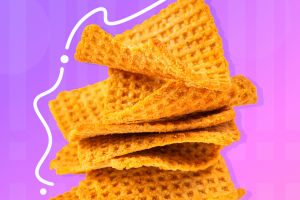Outside of Belgium, Belgian waffles are a variety of waffle with a lighter batter, larger squares, and deeper pockets than American waffles.
Belgian waffles were originally leavened with yeast, but baking powder is now often used. They are often eaten as a breakfast food; toppings vary from whipped cream, confectioners sugar, soft fruit, and chocolate spread, to syrup and butter or margarine. They may also be served with vanilla ice cream and fresh fruit (such as strawberries) as a dessert.
In Belgium itself, there are several kinds of waffle, including the Brussels waffle and the Liège waffle.
Belgian waffles are usually thicker than their American counterparts. These Belgian beauties are made with a recipe that includes yeasted batter and crunchy pearl sugar. Belgian waffles have extra-deep pockets—the better for filling with butter, jam, maple syrup, or whipped cream. They’re sometimes made with egg whites to give them their signature crispy-on-the-outside, fluffy-on-the-inside texture. They have a lovely golden exterior, making way to an airy inside.
Food historians trace the birth of the waffle back to ancient Greece, when two metal plates attached to a long wooden handle were used to roast flat cakes. Throughout centuries, waffles and the methods for making them changed and evolved.
Around the 15th century, Dutch wafel makers began to use the famous grid pattern that’s now intrinsic to waffles. Some say it was a way for cooks to use less batter to cover a greater surface—although we don’t know for sure, this was the start of waffles that we would recognize today, with their delicious little grooves.
A regular waffle (a typical American waffle) has a denser texture, like cake. Traditional waffles are often made with buttermilk, which gives them a richer flavor than the light-as-air Belgian variety.
American waffles are usually made with a smaller waffle iron that doesn’t make pockets as deep as the Belgian waffle maker. Because of the waffles’ thinner size, they cook faster.
The irony of the Belgian waffle's popularity in the U.S. -- and it being a representation of the country's cuisine -- is that the large, heavily loaded breakfast item that graces so many of morning menus has little resemblance to the original waffle that hails from Belgium. Actually, the American breakfast version pales in comparison to the waffle sold all over Belgium, where it is a traditional street food eaten with your hands (not a calorie-laden meal served with gallons of syrup). In Belgium, the treat is the waffle itself because they're so well made; they aren't just a vehicle for toppings.
The Belgian waffle made its first American appearance at the 1962 World’s Fair in Seattle. But it was at the 1964-65 World's Fair hosted in Queens, N.Y that Belgian native Maurice Vermersch and his family made the waffle's popularity skyrocket. Originally known as the Brussels waffle, named for the capital city from which it comes, the crisp-on-the-outside, airy-on-the-inside waffle was served two ways: the traditional fashion (plain) and with a slight embellishment of freshly whipped cream and just-sliced strawberries. The demand was so great that the family had to hire a team of 10 people just to slice strawberries — this doesn’t account for those whipping the cream, piping that whipped cream or cooking up the waffles on the 24 machines they had running.


